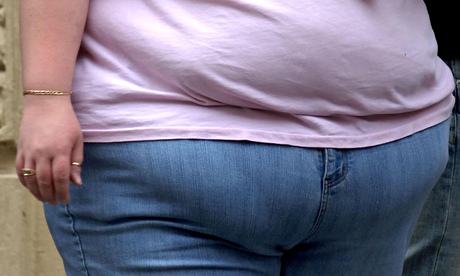
Nearly two-thirds of adults in England are overweight, according to new data from the government's public health agency that pinpoints the country's most overweight areas.
Copeland, Cumbria, has the most overweight people in England, according to the data from Public Health England. The analysis shows that more than three-quarters of Copeland's population (75.9%) are overweight or obese.
Doncaster, south Yorkshire, has the second highest population of overweight people with 74.4%, while East Lindsey, Lincolnshire, comes third, with 73.8%.
Public Health England says that across the entire country 64%, or nearly two-thirds of adults, are overweight.
While the numbers vary, most of the population is overweight. The lightest region is London, with 57% overweight, while the north-east tops the regional league, with 68% of the population overweight. The north-west is just behind, on 66%.
The agency points out that the rate of increase of obesity and overweight appears to be slowing in adults and children, but there are indications the stabilisation is occurring in more affluent areas.
There are 19 district local authorities where more than 70% of adults are overweight or obese, including County Durham, Bolsover, Blackpool, Scarborough, Basildon and Thurrock.
Obesity puts people at increased risk of heart disease, stroke, diabetes, cancer and other diseases, and there is great concern over the potential burden on the NHS as people get older and the toll of obesity-related illness rises.
The government has given responsibility for public health to the local authorities so that they can focus on the issues that most affect their populations. Public Health England advises councils on measures that are thought to be effective.
"Local authorities are ideally placed to develop co-ordinated action across their departments, services and partner organisations to tackle overweight and obesity in the local population," said Kevin Fenton, director of health and wellbeing at PHE. "Many local authorities are already working hard to reduce obesity levels and these new data will help all local areas monitor their progress in tackling these long-standing problems. Public Health England is committed to supporting local government and the local NHS.
He added: "People who are overweight or obese have an increased risk of developing type-2 diabetes, heart disease and certain cancers. Excess weight can also affect self-esteem and mental health. Overall, health problems associated with being overweight or obese cost the NHS over £5bn each year."
But the British Heart Foundation is among the campaigning health bodies that believe this is not an issue that can be left to local authorities to sort out alone. Many believe the government will have to bring in regulations to control the marketing of unhealthy food, and there are calls for a tax on sugar-sweetened drinks.
Joseph Clift, policy manager at the British Heart Foundation, said: "These new figures hold a mirror in front of the country's waistline and it reflects a very unhealthy picture. Put simply, too many people weigh too much. This should be a catalyst for action at local and national level. The Westminster government needs to introduce consistent regulation for advertising unhealthy products on TV and online to stop food companies exploiting loopholes.
"Local authorities need to be designing towns and cities in ways which encourage people to be more active, whether that's by walking or cycling. They also need to ensure everyone has access to high-quality green spaces where people can play sport or be active."
• This article was amended on Wednesday 5 February 2014. It was unclear whether the original image was of a pregnant woman or an obese person. The image has now been changed.

